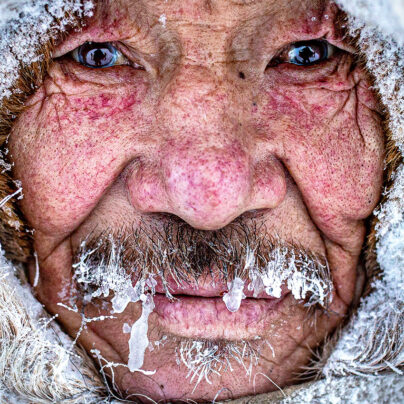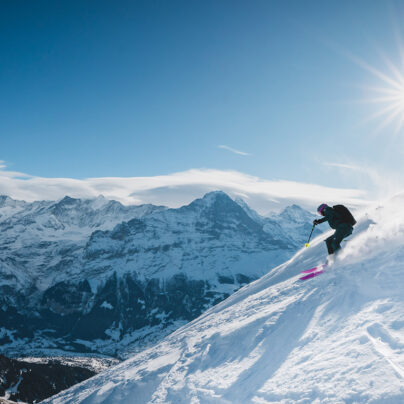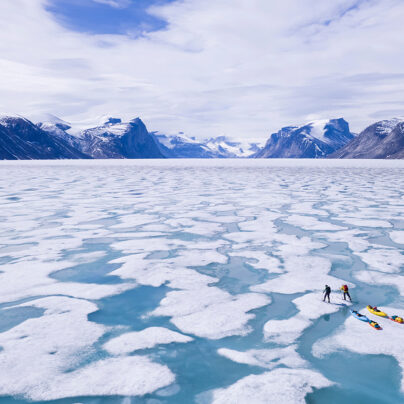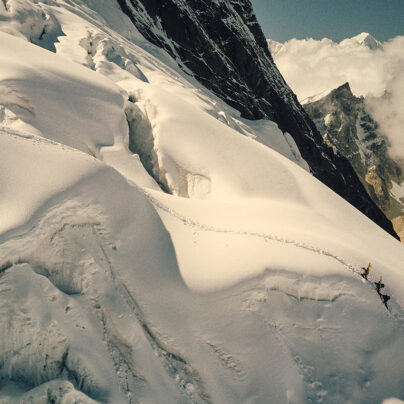Guardians of the Forest
Words and Photography by Joel Redman
The Guna people are threatened by climate change and tensions with the Panamanian government. Stewards of the forests and seas that sustain them, the Guna strive to protect their ancestral home.
Indigenous Guna biologist Heraclio Herrera is a tall, confident man, and he greets us with a warm and relaxed smile. The Caribbean Sea laps gently at our feet. Above us, the sky is a uniform blue with not a single cloud. To get here we have driven through a lush tropical rainforest filled with views to tempt any photographer, and now the four of us look out for the small wooden boat that will transport us to Isla Soledad Mandinga. Standing alongside me are Heraclio, filmmaker Jaye Renold, and my brother Paul Redman, a filmmaker and the founder of Indigenous charity If Not Us Then Who?
The boat arrives and we get on board. The San Blas Islands consist of close to 400 tiny islands scattered along the Caribbean coast of Panama. Isla Soledad Mandinga, which we are now approaching, squats close to the ocean and is no more than 100m in length. It’s home to around 50 wooden huts crowded closely together, and I study the buildings with curiosity as we dock. They appear to be mainly built from wooden supports with roofs of bamboo and dried leaves. Palm trees and other tropical greenery protrude between the homes. The islanders welcome us warmly – gentle handshakes from the men gathered, and the women, more reserved, are dressed in their traditional clothing of brightly coloured molas and beads. The mola is a traditional hand-made blouse worn by the women of the islands – garments not only beautiful but a true piece of the Guna’s past and present. Children skirt around nearby in small gangs, giggling at the new arrivals.
We are shown to the central wooden community building. Lined by pews and with a floor of dry, compacted sand, it’s a large and welcoming space where the island community can gather. Solid wooden struts are offered as supports for our hammocks. This will be our base for the coming days. I feel privileged that we have been invited to this community’s tranquil island home.
I have been fortunate to travel to many Indigenous communities through Indigenous-led charity If Not Us Then Who? – a charity I have been involved with since its inception – documenting and creating stories alongside Indigenous youth. We undertake workshops in photography and filmmaking, helping these young people to establish themselves as filmmakers and photographers and create stories of their own communities. Years later we now support many Indigenous creatives globally through mentorship programs, and through the distribution of their powerful stories – stories of community, climate change, the environment, stewarding of the land, and protection of fragile ecosystems.
Guna Yala is home to the sovereign tribal people known as the Guna. After a revolutionary past, the Guna now have autonomy over the forests they use for food and supplies – and the islands they call home. The Guna are native to this land and have resided here since well before Panamanian independence, Spanish rule, and colonisation. Yet the boundaries of their land remain disputed between the people and the government. These disputed boundaries are of huge importance to the Guna for many reasons, but climate change is foremost among them. Their low-lying island homes may not exist by the end of the 21st century. During our exploratory trips to the forested mainland in the coming days, we come to understand more of this threat – and the myriad other threats they face.



We accompany some of the elders and young men on a short journey across the sea to the banks of the forested shoreline, up a small tributary river, and deep into the tropical rainforest. It’s warm and humid as we leave the boats and begin our expedition. Astonishing sights and sounds envelop us around every corner. We cross forest streams and walk past armies of leafcutter ants, see toucans flying from tree to tree, hear monkeys chit-chatting to each other in the distance, and periodically meet members of the community returning from foraging or hunting.
After an exhausting journey laden down with equipment, we are welcomed into a large clearing by some of the group who had walked ahead. Like an oasis, a makeshift camp appears: various wooden structures to shelter from the rains, areas to store pots and pans, small garden patches of edible plants and herbs. Cooking smells fill our senses from the large pots bubbling on the fires. Along with other elders and youths of the community, we are joined by Heraclio, our constant in all these journeys, as well as Avelino Perez and Isaac Bastidas, both members of the Guna Yala Boundaries Commission. Tomorrow they will invite us to patrol the new proposed borders with them, gathering GPS coordinates and markings to present to government officials. Now, however, it’s time to sit by the fires, discuss maps and routes for the next morning, tell stories, and enjoy some warm food from those steaming pots.
Through the regulations they have set themselves, Guna communities are obliged to defend their land and regulate claims about its limits. Young men are therefore required to participate in patrols through the forest. One of the Guna elders pokes at the fire with a stick, and says, ‘The state of Panama made limits to the Guna Yala without consulting our authorities, but the ground has belonged to our ancestors our entire lives. So the young people are involved in recouping. If we do not fight we expect our grandchildren to be landless.’
Later, Jaye and I set up our hammocks and mosquito nets in an open-sided wooden shelter with the others. Paul, keen to try out his new hammock enclosed within its own mosquito net, sets up amongst the trees instead. I’ve always slept well in these settings, but as dawn approaches – it feels earlier – Jaye and I are woken once or twice by the cacophonous territorial cries of howler monkeys, and I wonder how Paul will be faring out there in the forest, isolated from the community. I peer out into the gloom. He and his hammock seem intact.
After an early breakfast, we confirm the route and are soon off on patrol with many of our new friends, georeferencing points along the route with handheld GPS devices. Soon enough the tropical heat is searing. After walking for some time through the dense forest, and with beads of sweat dripping from his brow, an emotional Avelino Perez – one of the elders, although still physically strong – speaks of the forest patrols and his people’s predicament. ‘With talk about climate change and sea levels rising, the Guna who live on the islands will, I’m sure, be here on the mainland in 20 or 30 years. This is why if the state takes it away we are left with nothing.’



The global north and west continue to consume vast amounts of the fossil fuels that power their economies. But at what cost? And who are the victims? The Guna have a deep ancestral relationship with this ecosystem and are alive to its sights, smells, and sounds, deeply knowledgeable about its flora and fauna. One of the younger Guna men, Ronel Morales, elaborates. ‘We are fighting because if they take this, where are we going to feed? They will remove our meat, remove our pharmacy, and take our produce.’
The following afternoon we return to the forest to learn more about the pharmacy that Ronel mentioned. Now we are accompanied by Ramiro Martinez – an elder who is hard to label, but can perhaps best be described as a botanist and naturopath. As we move into the rainforest he tiptoes respectfully, almost kissing the ground with his feet. He is gathering medicinal plants as he’s always done – just as his ancestors would have done. His knowledge of these plants and their extensive benefits seems without limit, but the leaves and roots he has collected on this trip are mainly for the women of the island in times of menstruation and childbirth. Once Ramiro has gathered everything into his basket, he finally gives thanks to the land, and only then do we make our way back to the boats.
In the late afternoon we return to the island over a tranquil sea. It’s overcast, the light soft, and the sky bleeds into the water. Every ripple of Ramiro’s oar is visible as we trail his boat back home.
***
The Guna have fought for and won many rights to the land they steward, and in ways that we can learn from. Through their efforts 80 per cent of their land remains forested. However, they face increasing threats at sea, especially from the cruise ships and luxury yachts that share the waters close to their island homes. In many cases, these vessels leave behind pollution and contribute to the destruction of the fragile reefs, ecosystems, and unique biodiversity that exists here. Now the Guna are seeking protection for the water systems they depend upon.
We head out to witness some of this story with Katrina Fernandez, the tourism inspector for the Guna Yala General Congress Ministry of Tourism. As we board the boat, her manner is gentle but assertive, and she is far more adept on the water than Jaye, Paul, and I with our cumbersome bags. Her black hair is swept back behind a headband of colourful geometric patterns. Guna biologist Heraclio Herrera also joins us on our patrol of the waters.
As we make our way between the islands we notice a ferry abandoned on a reef, its sides streaked with rust. Katrina talks of what they hope to achieve. ‘We come here to patrol, to see if the sailboats are in order. The state government of Panama does not give much importance to the Guna Yala region. Here you will not see a boat from the maritime authority.’



Skipping from yacht to yacht, we listen to the discussions between Katrina and the skippers of the luxury vessels. The Guna have been trying to establish a small maritime fee for boats using these waters. Many on board the yachts are either unaware of who has authority or are confused by the Panamanian government’s messaging on this issue. ‘The problems between Panama and Guna Yala are not our problems,’ one skipper says. Katrina nods briskly and we move on without a confrontation. Although she gathers more sympathy than fees, a few responsible owners agree to pay. ‘In the future we don’t want as many boats as there are now,’ she tells us. ‘They bring problems, throw garbage out to sea.’
Now we approach the wrecked ferry, and I get a closer look at the hulk. Heraclio tells us that this Austrian vessel ran aground in 2016. ‘It is a danger to all of us if the diesel escapes,’ he says. ‘It will damage the entire marine ecosystem and biodiversity will be killed. We feel very offended that the government of Panama does not cooperate with the Guna people. The Indigenous people depend on and take care of nature, whether on land or sea. The government do not plan to cooperate with the Indigenous, the Guna people, to see how we maintain mother nature.’
***
On one of our final days we head out with a young man, Elith Paredes, an accomplished freediver. His body is attuned to the depths he must dive to in order to find lobster and crayfish, which he uses to feed his family as well as selling locally. He’s wearing a basic set of flippers, goggles, and a snorkel as he drops backwards off the dugout canoe and swims with elegant ease down to depths of 8–12m. Fancying a swim ourselves, my brother Paul and I jump in. We try to swim as deep as possible in order to observe Elith, but there is little chance of staying close – I’m a good swimmer but well out of my depth here. We swim a while longer and Elith brings up one or two catches.
I love the water deeply – I was brought up near the sea – and I will cherish these moments. With our time among the Guna drawing to an end, I reflect on an amazing experience. That night we say goodbye to the beautiful people we have shared our time with on Isla Soledad Mandinga. We leave new friends behind, and promise to continue to support their incredible fight – a fight, and a resolve, that results in the protection of the forests, islands, and water systems they call home.
Indigenous peoples make up five per cent of the world’s population, but they are the guardians of 80 percent of Earth’s biodiversity. They are at the forefront of the climate fight – the first affected, the first to put their bodies on the line. They have deep connections to our world, and it is vital that we support them. Their fight is ours too.
First published in Sidetracked Volume 25
Please support Indigenous storytellers and help us all become more engaged in a path towards improved planetary health. ifnotusthenwho.me is a great place to begin.
Joel Redman // @joelredman1 // joelredman.com
If Not Us Then Who // @ifnotusthenwho







